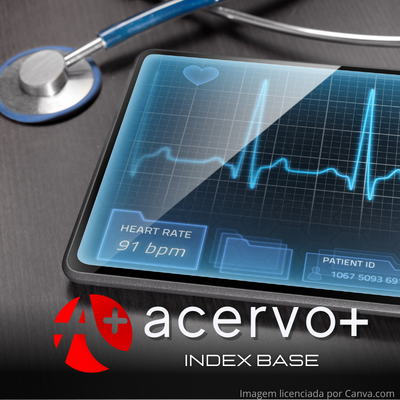Densidade das arritmias supraventriculares e ventriculares em pacientes com síndrome metabólica
##plugins.themes.bootstrap3.article.main##
Resumo
Objetivo: Revisar na literatura científica sobre as Arritmias Supraventriculares e Ventriculares em pacientes com Síndrome Metabólica (SM). Métodos: Revisão integrativa da literatura, com buscas no Pubmed, Google Scholar, Lilacs, de artigos dos últimos 10 anos. Os descritores utilizados foram ¨Metabolic Syndrome¨ AND ¨Arrythmia¨. Critérios de Inclusão: (1) ser realizado em humanos; (2) ter como amostra pessoas acima de 18 anos; (3) utilizar como critério de SM os parâmetros estabelecidos pela OMS, NCEP-ATPIII ou IDF; (4) possuir um grupo controle; (5) a população em estudo não possuir outras comorbidades crônicas tais como esclerose múltipla, doença renal crônica, problemas cardíacos e outros; (6) correlacionar os parâmetros das arritmias cardíacas com a SM entre pacientes SM- e SM+. Resultados: Oito artigos atenderam aos critérios de inclusão. Todos os artigos trabalharam com pessoas provindas da população geral. Ambos os sexos foram abordados nos trabalhos. Fibrilação Atrial (FA) foi a arritmia predominante. Os fatores mais relevantes quando avaliados individualmente foram HAS e Obesidade Abdominal. Considerações Finais: Quanto mais grave for o quadro de SM do paciente, mais grave será a arritmia. Logo, evidencia-se a importância de manter um estilo de vida saudável para evitar o desenvolvimento de fatores de risco desencadeantes da Síndrome Metabólica.
##plugins.themes.bootstrap3.article.details##
Copyright © | Todos os direitos reservados.
A revista detém os direitos autorais exclusivos de publicação deste artigo nos termos da lei 9610/98.
Reprodução parcial
É livre o uso de partes do texto, figuras e questionário do artigo, sendo obrigatória a citação dos autores e revista.
Reprodução total
É expressamente proibida, devendo ser autorizada pela revista.
Referências
2. AHN HJ, et al. Cumulative burden of metabolic syndrome and its components on the risk of atrial fibrillation: a nationwide population-based study. Cardiovascular diabetology, 2021; 20(1): 20.
3. CHRISTENSEN RH, et al. Effect of Aerobic and Resistance Exercise on Cardiac Adipose Tissues. JAMA Cardiology, 2019; 4(8): 778.
4. DECKER JJ, et al. Metabolic Syndrome and Risk of Ischemic Stroke in Atrial Fibrillation: ARIC Study. Stroke, 2019; 50(11): 3045–3050.
5. DELHEY L, et al. The association of metabolic syndrome and QRS|T angle in US adults (NHANES III). Annals of noninvasive electrocardiology : the official journal of the International Society for Holter and Noninvasive Electrocardiology, Inc, 2020; 25(1): 1-8.
6. FARAMAWI MF, et al. Metabolic syndrome and P-wave duration in the American population. Annals of epidemiology, 2020; 46: 5–11.
7. FUMAGALLI C, et al. Association of Obesity With Adverse Long-term Outcomes in Hypertrophic Cardiomyopathy. JAMA Cardiology, 2020; 5(1): 65.
8. GOONASEKARA, CL, et al. Cholesterol and cardiac arrhythmias. Expert review of cardiovascular therapy, 2010; 8(7): 965–979.
9. HOHL M, et al. Concomitant Obesity and Metabolic Syndrome Add to the Atrial Arrhythmogenic Phenotype in Male Hypertensive Rats. Journal of the American Heart Association, 2017; 6(9): 17.
10. KÄRÄJÄMÄKI AJ, et al. Long-term metabolic fate and mortality in obesity without metabolic syndrome. Annals of medicine, 2022; 54(1): 1432–1443.
11. KURT M, et al. The relationship between atrial electromechanical delay and P-wave dispersion with the presence and severity of metabolic syndrome. Turk Kardiyoloji Dernegi arsivi : Turk Kardiyoloji Derneginin yayin organidir, 2012; 40(8): 663–670.
12. LAVIE CJ, et al. Obesity and Atrial Fibrillation Prevalence, Pathogenesis, and Prognosis: Effects of Weight Loss and Exercise. Journal of the American College of Cardiology, 2017; 70(16): 2022–2035.
13. LEE HC, et al. Very-Low-Density Lipoprotein of Metabolic Syndrome Modulates Gap Junctions and Slows Cardiac Conduction. Scientific reports, 2017; 7(1): 1-12.
14. LEE SY, et al. Association Between Change in Metabolic Syndrome Status and Risk of Incident Atrial Fibrillation: A Nationwide Population-Based Study. Journal of the American Heart Association, 2021; 10(16): 1-23.
15. MAGNANI JW, et al. P wave indices, obesity, and the metabolic syndrome: the atherosclerosis risk in communities study. Obesity (Silver Spring, Md.), 2012; 20(3): 666–672.
16. NYSTRÖM PK, et al. Obesity, Metabolic Syndrome and Risk of Atrial Fibrillation: A Swedish, Prospective Cohort Study. (N. Maeda, Org.)PLOS ONE, 2015; 10(5): 111-127.
17. ORNELAS-LOREDO A, et al. Association Between Obesity-Mediated Atrial Fibrillation and Therapy With Sodium Channel Blocker Antiarrhythmic Drugs. JAMA Cardiology, 2020; 5(1): 57.
18. PAPADOPOULOS CH, et al. Echocardiography and cardiac arrhythmias. Hellenic journal of cardiology : HJC = Hellenike kardiologike epitheorese, [S.d.]; 59(3): 140–149.
19. PARK B, et al. Metabolic syndrome and its components as risk factors for prolonged corrected QT interval in apparently healthy Korean men and women. Journal of clinical lipidology, 2018; 12(5): 1298–1304.
20. ROCHLANI Y, et al. Metabolic syndrome: pathophysiology, management, and modulation by natural compounds. Therapeutic advances in cardiovascular disease, 2017; 11(8): 215–225.
21. SAFRANOW K, et al. Inflammation markers are associated with metabolic syndrome and ventricular arrhythmia in patients with coronary artery disease. Postepy higieny i medycyny doswiadczalnej (Online), 2016; 70: 56–66.
22. THOMSEN M, et al. Myocardial Infarction and Ischemic Heart Disease in Overweight and Obesity With and Without Metabolic Syndrome. JAMA Internal Medicine, 2014; 174(1): 15.
23. WANG TJ, et al. Obesity and the Risk of New-Onset Atrial Fibrillation. JAMA, 2004; 292(20): 2471.

